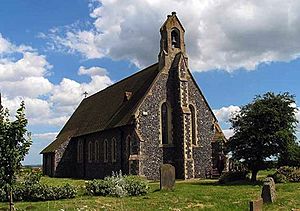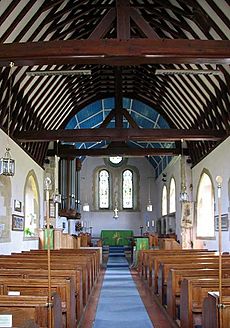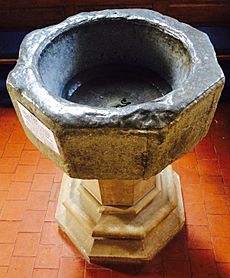Church of St Mary the Virgin, Reculver facts for kids
Quick facts for kids Church of St Mary the Virgin, Reculver |
|
|---|---|

The church viewed from the north-west in 2008
|
|
| Lua error in Module:Location_map at line 420: attempt to index field 'wikibase' (a nil value). | |
| OS grid reference | TR 212 680 |
| Location | Reculver Lane, Hillborough, Kent |
| Country | England |
| Denomination | Anglican |
| Website | United Benefice of St. Mary the Virgin, Reculver, St. Bartholomew, Herne Bay & Holy Cross, Hoath |
| History | |
| Status | Parish church |
| Dedication | St Mary |
| Consecrated | 12 June 1878 |
| Architecture | |
| Functional status | Active |
| Heritage designation | Grade II |
| Designated | 14 May 1975 |
| Architect(s) | Joseph Clarke |
| Style | Gothic Revival |
| Completed | 1878 |
| Construction cost | £1,400 |
| Specifications | |
| Capacity | 150 |
| Materials | Knapped flint with limestone dressings Red clay tiled roof |
| Bells | 1 |
| Administration | |
| Parish | Reculver |
| Diocese | Canterbury |
The Church of St Mary the Virgin, Reculver, is an Anglican church in the village of Hillborough, Kent, in England. An Anglican church is part of the Church of England, a branch of Christianity. This church was built between 1876 and 1878, but it has a much longer history.
It is the third church to serve the local community, known as a parish. The first church was incredibly old, founded in the year 669 inside an ancient Roman fort. It was torn down in 1809. The second church, built to replace it, was poorly made and didn't last long.
The current church was built in the Gothic Revival style, which was popular in the 1800s and copied the look of medieval cathedrals. It even uses some stones from the original church. Because of its special history and design, it is a Grade II listed building, meaning it is officially protected as an important part of England's heritage.
Contents
The Story of Reculver's Churches
The parish of Reculver has had three different churches dedicated to St Mary over the centuries. Each one tells a part of the area's long history.
The First Church: An Ancient Building
The very first church was founded in 669 AD. It was built inside the walls of Regulbium, a fort built by the Romans hundreds of years earlier. For about 1,150 years, this church was a landmark.
By the early 1800s, the sea was washing away the land around the church through a process called coastal erosion. The village it served had also mostly disappeared, with people moving inland to Hillborough. In 1809, the church leader, called a vicar, decided to demolish the church with gunpowder. He worried it would soon fall into the sea.
Not everyone agreed with this. Many people felt that destroying such an ancient and historic building was a terrible mistake.
The Second Church: A Temporary Replacement
A new, second church was built in Hillborough, where the villagers now lived. It was finished in 1813 and used some materials saved from the old church.
However, this building was not well made. One writer in 1856 called it a "miserable little church" that was built cheaply. By 1874, its roof was leaking and the building was falling apart. It was clear that the parish needed a better, more permanent church.
The Third Church: The Building We See Today
The local vicar, R. H. Blakey, started raising money to build a brand new church. The current Church of St Mary the Virgin was built on the same spot as the second one. It was designed by an architect named Joseph Clarke and cost £1,400 to build.
The new church was officially opened, or consecrated, on 12 June 1878. It was designed to last and to be a beautiful place for worship.
Architecture and Special Features
The church was built in the Gothic Revival style, which means it looks like a much older medieval church with pointed arches and detailed stonework.
What is the Church Made Of?
The outside walls are made of knapped flint. This means that flint stones were carefully split to create a flat, glassy surface, which gives the walls a unique texture. The corners and window frames are made of limestone.
The roof is covered with red clay tiles. On top of the west wall, there is a small stone structure called a bellcote that holds one bell. The original bell was made in 1635 for the first church, but it was stolen in 1970 and had to be replaced.
Inside the Church
When you enter the church, you walk through a stone doorway that is over 700 years old. It was saved from the first church at the Roman fort. Inside, you can also see other old stones and memorials from the original church set into the walls and floor.
The main part of the church is called the nave, and the area near the altar is the chancel. The wooden beams in the nave's ceiling are exposed, while the chancel has a curved, blue-painted ceiling that looks like a barrel.
The Ancient Baptismal Font
One of the most interesting items is the baptismal font, a large stone basin used for baptisms. This font is even older than the church and didn't come from the first Reculver church.
It probably came from the medieval All Saints' Church on the nearby Isle of Thanet. That church disappeared centuries ago, and the font was saved and given to St Mary's. It is octagonal (eight-sided) and was made in the 14th or 15th century.
The Church Today
The Church of St Mary the Virgin is still an active parish church. It holds regular services and serves the communities of Reculver, Herne Bay, and Hoath.
Outside the church is a graveyard and a war memorial. The memorial was put up in 1919 and lists the names of 27 people from the parish who died in the First and Second World Wars.



